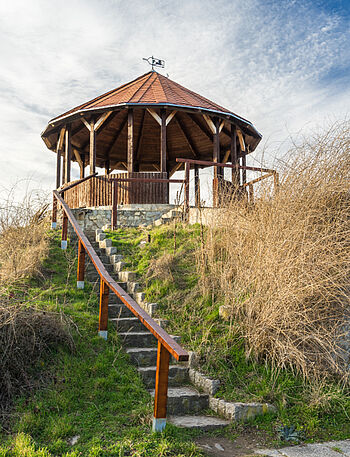
The Heimburg Castle is first mentioned in a construction account from the bishop and architect Benno von Osnabrück from the year 1070, who on behalf of Emperor Henry IV rebuilt and fortified the Harzburg and Heimburg. The ruins of Heimburg with its former ditches and ramparts that still stand out on the slopes of the castle hill, rises north of the village of Heimburg, and stand as testimony to this once great castle. Lime-sandstone layers from the Upper Cretaceous period formed the foundation for a hilltop castle here. The castle square is 276 m above sea level.
A free-standing round Keep (Bergfried) at the northern tip has belonged to the castle since the Middle Ages. The Romanesque core castle was provided with a circulating ring or curtain wall. Remnants of buildings standing on this wall have been archaeologically proven and in some cellars are still located. In 1313 a castle chaplain officiated in the Heimburg chapel, which can no longer be located. Vaults and foundations also within the castle square with the extension of approx. 35 x 60 m testify to the dense development of the core castle up to the late Middle Ages. Around them on the west, south and east sides, was the lower castle with the remains of the ring wall, the fountain, cellars and gatekeepers on the southern tip. Quarry sandstone was used as building material.
The castle was thus located on the grounds of "Altenburg", whose name itself may indicate a prehistoric or early historical complex located in the same place. In 1073 Lambert von Hersfeld also mentions the "Heimenburg" as an imperial castle. The wall technique and the expansion of the castle complex point to an origin of the Salian dynasty. The castle fell into the hands of conquerors several times. In 1123 Lothar von Süpplingenburg, attacking from Blankenburg, took the Heimburg. They were then occupied by a Welf ministerial family and finally by the Counts of Blankenburg-Regenstein. In 1553, repair work at the Heimburg castle is noted again. During this time, Count Ernst temporarily moved his residence to the Heimburg. Even before the count family died out in 1599, the complex appeared to be in a state of decay.
In the Topography of the Merian, published in 1654, the fortress was depicted as a ruin. It is uncertain to what extent today's farmyard served as a fortress.
In 1820, the landlord Eggeling had a wooden pavilion built on the ruins of the castle. Today's viewing pavilion was built in 1992/93.
Important lords of the castle were the Ministerialis Anno von Heimburg, who belonged to the court of Henry the Lion and later Count Albrecht II of Regenstein / Heimburg.